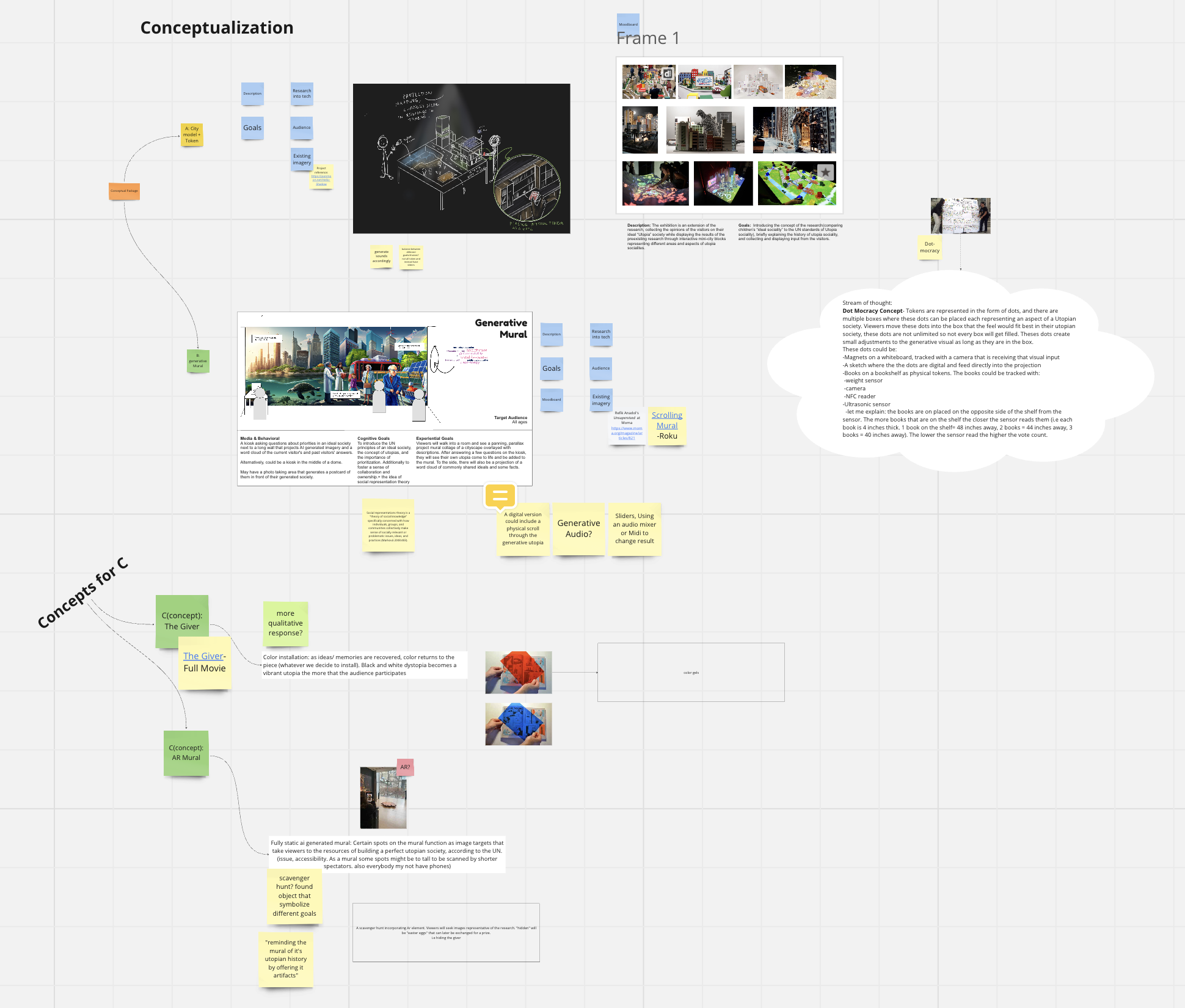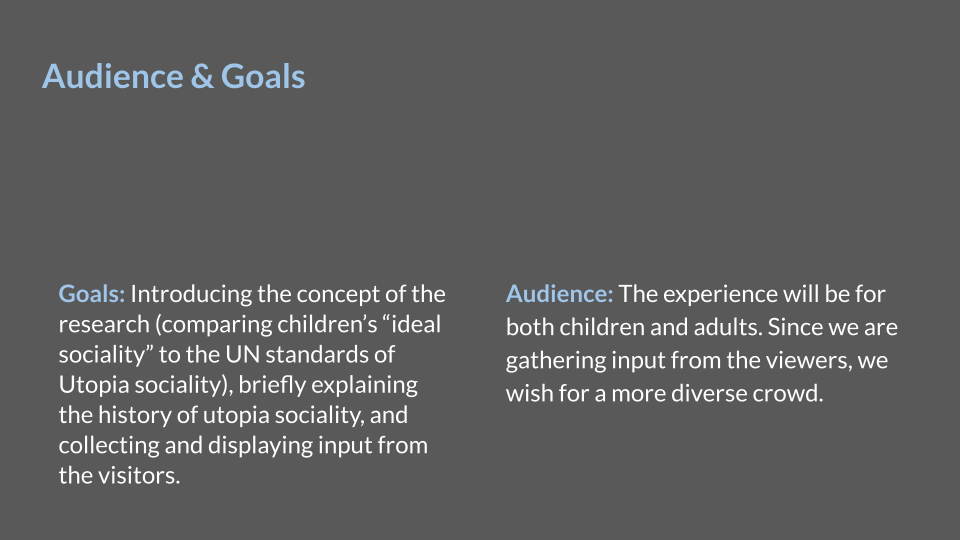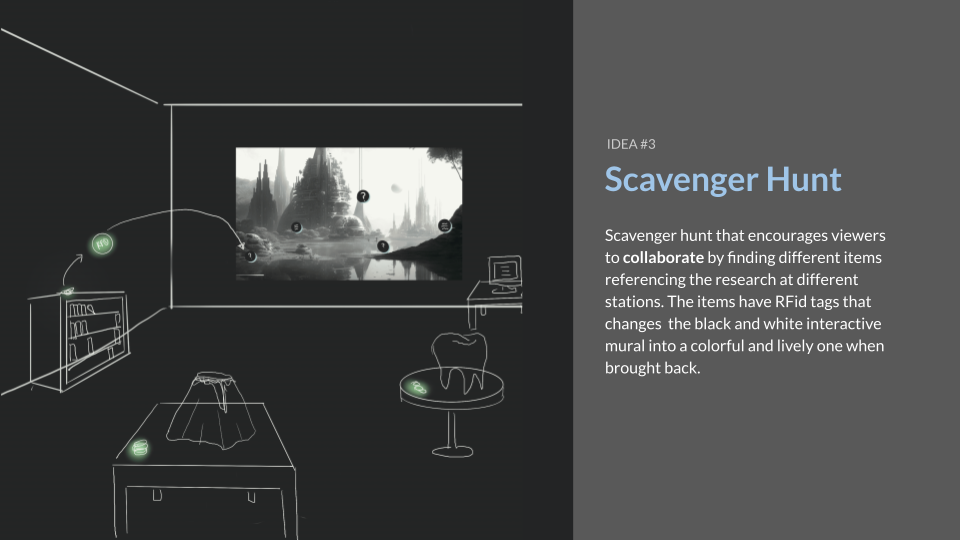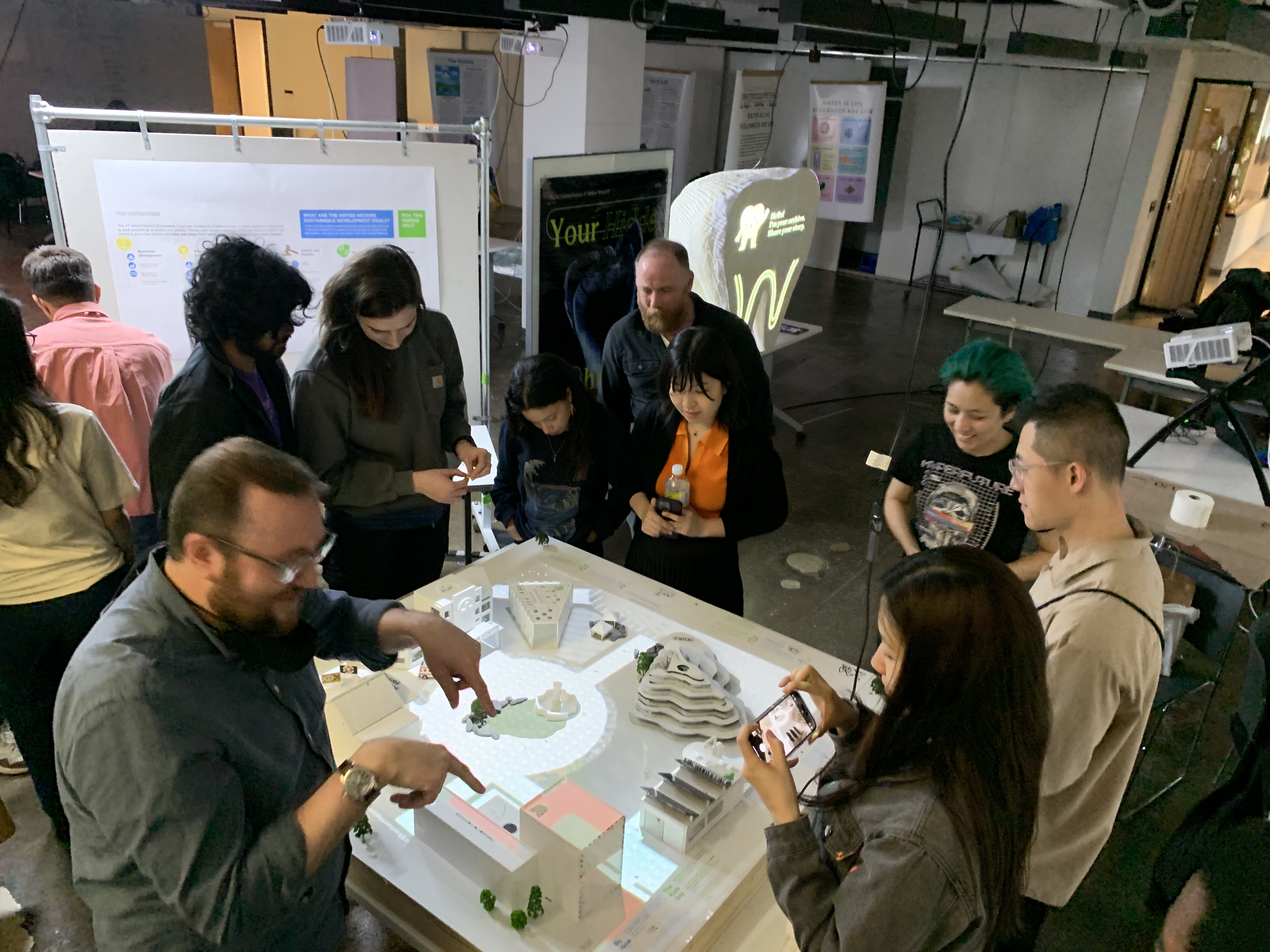Youtopia
#Projection-based #Interactive Installation #Playful Communications for Serious Research #UN SDGs #Collective Opinions #Utopian Thinking
Youtopia is a projection-based interactive installation that visualizes people’s visions on an ideal society.
The project is based on an NYU research on children’s social representations of utopian societies.
The project is based on an NYU research on children’s social representations of utopian societies.
Timeline: February - May 2023
Tools: Arduino, TouchDesigner, Adafruit APDS9960 proximity sensors, laser cutting, projection
Exhibition: Spring Show 2023 @NYU ITP
Tools: Arduino, TouchDesigner, Adafruit APDS9960 proximity sensors, laser cutting, projection
Exhibition: Spring Show 2023 @NYU ITP
Team: Bruce Arthur Jr., Jaxon Wang, Karina Chow, Lily Yu, and Queenie Huang
My Role:
My Role:
- Concept ideation
- Interaction design
- Physical computing
- Fabrication
01. Ideation & Research
We initiated our research by reading through the original research, the novel The Giver that the research was highly relevant to, as well as the 17 UN Sustainable Development Goals (UN SDGs) that the research was based on. Based on our initial understanding of the research, we started with some general ideation to organize our thoughts. We also proceeded to develop a few potential ideas as well as a moodboard.
![]()
![Idea Conceptualization]() General Ideation & Conceptualization
General Ideation & Conceptualization
![]()
Moodboard
We proceeded with contacting Dr. John Jost, one of the researchers who conducted the study. Luckily, we got the chance to interview him and his kid Elliot, who was also engaged in the research. The meeting helped us understand better their research process and the key messages that the researchers would hope to convey to a larger audience, among which, collective deliberation as a community is essential for a shared society stood out the most to us.
Based on our research, we identified our goal and target audience of this experience we would be designing:
![]()
We also developed our conceptual package and presented three potential ideas to our peers and guest critics from the American Museum of Natural History.
![]()
![]()
![]()

 General Ideation & Conceptualization
General Ideation & Conceptualization
Moodboard
We proceeded with contacting Dr. John Jost, one of the researchers who conducted the study. Luckily, we got the chance to interview him and his kid Elliot, who was also engaged in the research. The meeting helped us understand better their research process and the key messages that the researchers would hope to convey to a larger audience, among which, collective deliberation as a community is essential for a shared society stood out the most to us.
Based on our research, we identified our goal and target audience of this experience we would be designing:

We also developed our conceptual package and presented three potential ideas to our peers and guest critics from the American Museum of Natural History.



All three ideas felt strong to the guest critics: they appreciated our attempt to collect data/opinions from the audience and visualize them, as well as the collaborative interactions, which is a representation of how changes in a society happen in real life. They also posed some thought-provoking questions like: For Idea 2, how would we approach the potential issue with copyright/crediting of AI-generated content? For Idea 3, how would we create incentives to prompt the participants in the scavenger hunt?
Base on the feedback that we received from our peers and the guest critics, we decided to move forward with the first idea, the interactive city miniature projection.
Base on the feedback that we received from our peers and the guest critics, we decided to move forward with the first idea, the interactive city miniature projection.
02. Project Planning
We proceeded with creating a schematic package that would help us manage the project development process as well as our budget.
![]()
![]()

Gantt Chart

User Flow & System Diagram
03. Project Development
Paper & Cardboard Prototyping
We started with making simple prototypes using paper and cardboard for play testing. This approach was very effective in testing if the flow of the experience and the interactions would help to achieve our project goal.
![]()
![]()
![]()
Fabrication
After finalizing the design of the city models, we started fabrication using laser cutting.
![]()
![]()
![]()
![]()
![]()
![]()
Physical Computing & Projection Setup
With the models ready, we started testing sensors and wiring up circuits. Our original plan was to use the IR Break Beam sensors. However, we found that they were quite finicky to work with, especially when our building models and tokens are not in standard shapes. After struggling to figure out different ways to stabelize the performance of the break beam sensors for a while, we decided to try distance sensors and finally landed on APDS9960 because of its advantage in size.
![IR Break Beam Sensor]()
![Ultrasonic Distance Sensor]()
![Adafruit APDS9960]()
![]()
![]()
Information Design
We also designed the tokens, infographics on the tabletop, and a poster.
![]()
![]()
![]()
User Testing
Before the final exhibition, we did user testing with our peers and guest critics from the American Museum of Natural History to make sure the overall flow of the experience make sense.
![]()
Some Fun/Hectic WIP Moments :D
![]()
![]()
![]()
![]()
![]()
![]()
We started with making simple prototypes using paper and cardboard for play testing. This approach was very effective in testing if the flow of the experience and the interactions would help to achieve our project goal.



After finalizing the design of the city models, we started fabrication using laser cutting.






Physical Computing & Projection Setup
With the models ready, we started testing sensors and wiring up circuits. Our original plan was to use the IR Break Beam sensors. However, we found that they were quite finicky to work with, especially when our building models and tokens are not in standard shapes. After struggling to figure out different ways to stabelize the performance of the break beam sensors for a while, we decided to try distance sensors and finally landed on APDS9960 because of its advantage in size.



For projection mapping, we used TouchDesigner. We tested the mapping locations with color blocks while creating assets for each of the city models.


Information Design
We also designed the tokens, infographics on the tabletop, and a poster.
User Testing
Before the final exhibition, we did user testing with our peers and guest critics from the American Museum of Natural History to make sure the overall flow of the experience make sense.

Some Fun/Hectic WIP Moments :D






04. Final Work

